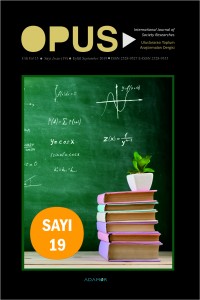Abstract
Akademiler daha çok formal eğitim ve öğretim
kurumları olarak algılanır. Akademi deyince akla hemen üniversiteler gelir.
Kurumsal hayatta da bir çok firmanın oldukça geniş olanaklara sahip eğitim
bölümleri bulunmaktadır ve kurumsal örgütlerin bir kısmının eğitim
fonksiyonlarını akademiye dönüştürme kararı yeni bir şey değildir. Özellikle
yabancı kaynaklarda otuz yıl öncesinde dahi birçok kurumsal firmanın bu
kararları çoktan almış oldukları ve eğitim bölümlerini kurumsal akademi
yaklaşımıyla yapılandırdıkları görülüyor. Bu durum kurumsal ölçeğe bağlı olduğu
gibi örgütlerin eğitim fonksiyonlarına yükledikleri anlam ve eğitimle ilgili
vizyonlarına da bağlıdır. Ülkemizde kurumsal akademilerin tarihçesinin o kadar
eskiye dayanmadığını ve nispeten daha yeni olduğunu anlıyoruz. Bazı öncü
kurumlar dışında akademisi olması gereken birçok kurumda akademiler ya yok, ya
da daha planlanma aşamasındalar. Bu araştırmada kurumsal akademilerin genel
gelişim süreçleri ile birlikte akademi modellerine yönelik tanımlayıcı bir
yaklaşımla bilgi verilmektedir. Uygun olduğu düşünülen bir akademi
yapılandırması yaklaşımı ve akademilerin değerlendirilmesine yönelik bir
değerlendirme enstrümanı da önerilmektedir. Kurumsal akademilerin örgüt
performansına olumlu katkıları da değerlendirilmiştir
References
- Crocetti, C. (2001). Corporate learning: A knowledge management perspective. The Internet and Higher Education, 4(3), 271-285.
- Marquardt, M.J. (1996). Building the learning organization. McGraw-Hill Companies, New York, NY.
- McAteer, P. ve Pino, M. (2011). The business case for creating a corporate university. NY: Corporate University Xchange.
- Meister, J. (2006). Corporate universities: What works and what doesn’t. Chief Learning Officer Magazine, 6(3), 28-70.
- Meister, J. (2009). Corporate universities 2.0: The future networked learning organization. In A. Romano & G. Secundo (Eds.), Dynamic learning networks: Models and cases in action, 137-149, Dordrecht: Springer.
- Morin, L. ve Renaud, S. (2004). Participation in corporate university training: Its effect on individual job performance. Canadian Journal of Administrative Sciences, 21(4), 295–306.
- Rademakers, M. (2005). Corporate universities: Driving force of knowledge innovation. Journal of Workplace Learning, 17(1/2), 130–136.
- Sham, C. (2007). An exploratory study of corporate universities in China. Journal of Workplace Learning, 19(4), 257–264.
- Shaw, S. (2005). The corporate university: Global or local phenomenon? Journal of European Industrial Training, 29(1), 21–39.
- Wheeler, K. ve Clegg, E. (2005). The corporate university workbook: Launching the 21st century learning organization. San Francisco: Pfeiffer.
Structuring of Corporate Universities as the Mechanisms for Developing the Efficiency of Training at Organizations
Abstract
Academies are generally perceived as universities or formal
educational institutions. Some companies
also have large training and development departments. Then, those departments
can also place them as centers for education and training for people and can
also be named as corporate universities. The decisions of organizations about
transforming training and education departments into corporate universities
(CU) are not new. It is seen in the foreign literature that major companies
have had transformed their training functions into corporate universities for decades
ago. It is also apparent that the CU approach has been recently developing in
Turkish organizational settings. Still, total number of corporate universities
in Turkey, when compared with other big economies of world, is few. Apart from
major big companies, organizations have not settled their corporate
universities. In this study, corporate universities are taken by a descriptive
approach. The advantages, pitfalls and the influences of CUs on organizational
performance are explained and a CU development and assessment model is
proposed.
References
- Crocetti, C. (2001). Corporate learning: A knowledge management perspective. The Internet and Higher Education, 4(3), 271-285.
- Marquardt, M.J. (1996). Building the learning organization. McGraw-Hill Companies, New York, NY.
- McAteer, P. ve Pino, M. (2011). The business case for creating a corporate university. NY: Corporate University Xchange.
- Meister, J. (2006). Corporate universities: What works and what doesn’t. Chief Learning Officer Magazine, 6(3), 28-70.
- Meister, J. (2009). Corporate universities 2.0: The future networked learning organization. In A. Romano & G. Secundo (Eds.), Dynamic learning networks: Models and cases in action, 137-149, Dordrecht: Springer.
- Morin, L. ve Renaud, S. (2004). Participation in corporate university training: Its effect on individual job performance. Canadian Journal of Administrative Sciences, 21(4), 295–306.
- Rademakers, M. (2005). Corporate universities: Driving force of knowledge innovation. Journal of Workplace Learning, 17(1/2), 130–136.
- Sham, C. (2007). An exploratory study of corporate universities in China. Journal of Workplace Learning, 19(4), 257–264.
- Shaw, S. (2005). The corporate university: Global or local phenomenon? Journal of European Industrial Training, 29(1), 21–39.
- Wheeler, K. ve Clegg, E. (2005). The corporate university workbook: Launching the 21st century learning organization. San Francisco: Pfeiffer.
Details
| Primary Language | Turkish |
|---|---|
| Subjects | Psychology |
| Journal Section | Articles |
| Authors | |
| Publication Date | September 30, 2019 |
| Acceptance Date | September 12, 2019 |
| Published in Issue | Year 2019 Volume: 13 Issue: 19 |


